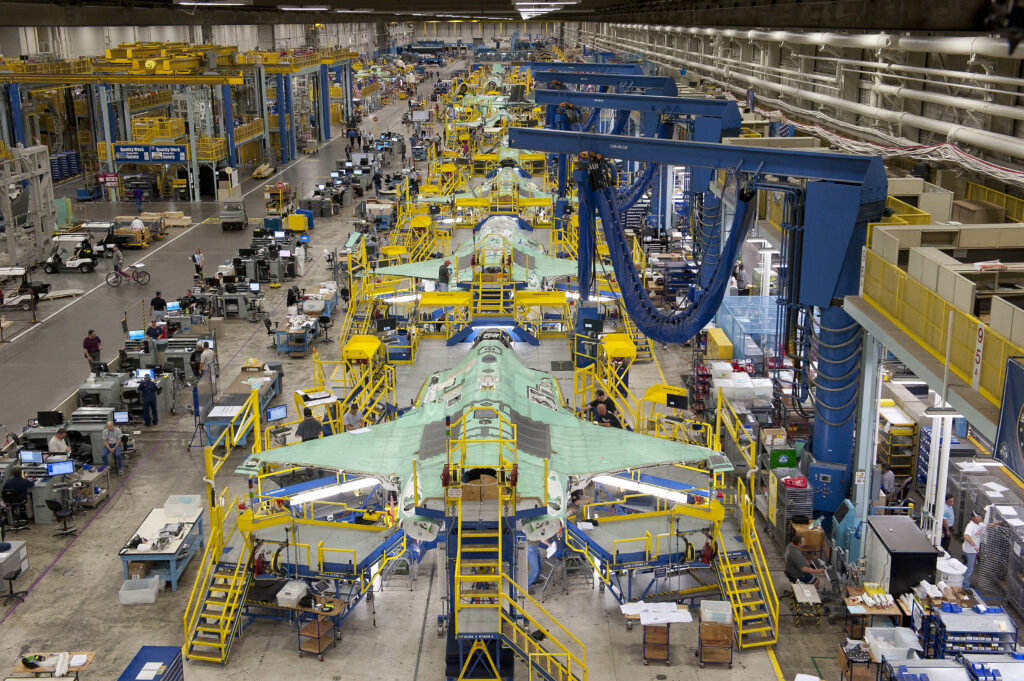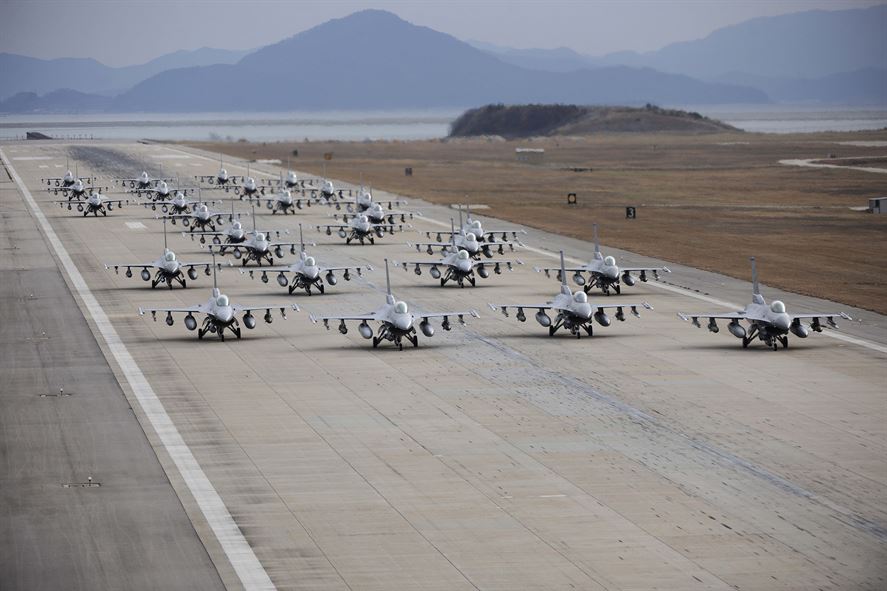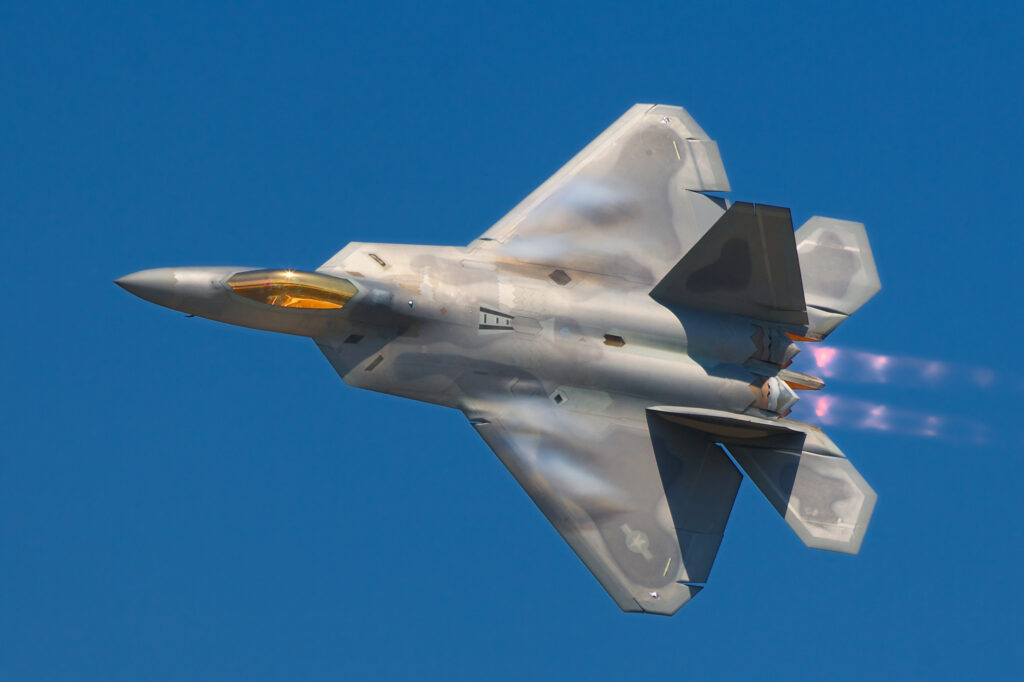America’s Air Superiority Crisis
Posted on

F-35 production line
The Air Force already has a big hole in its capabilities for the future: it needs what it is calling Penetrating Counter Air, a very fast, long-range, sensor-loaded and furiously lethal aircraft. But that effort is designed to fill a need in 2030. Dave Deptula, head of the Air Force Association’s Mitchell Institute and a former lieutenant general who orchestrated air operations over Iraq and Afghanistan, argues the US already faces a quantitative gap in America’s all-important efforts to ensure we own the skies in any battle. Read on! The Editor.
The United States Air Force is suffering an air superiority crisis after 26 years of combat operations. Today, the service possesses just under 1,000 aircraft capable of air-to-air combat — F-15s, F-16s, F-22s, and F-35s. That is down more than 65 percent since the end of the Cold War. Given the global demands of our national security strategy, operational considerations, and force rotation factors, this amounts to fewer than 100 fighter aircraft available in a particular location at any given time.
Fighters are employed in a rotational fashion—with one third of aircraft on station, another third returning to base, and the last third preparing to launch. That means in reality only about 30 fighters are immediately able to engage at any given time in a particular region. Put bluntly, that number does not cut it when it comes to projecting necessary air-to-air capability to meet increasingly lethal threats that are more challenging today than during the Cold War.

David Deptula
The country needs a full spectrum of capabilities and the strongest Army, Navy, Air Force, and Marine Corps in the world to meet the demands of our current national security strategy. Empowering that joint team means America needs a robust, properly sized fighter force. The paramount first step toward success in large-scale military operations is air superiority. Without it, all other military missions are at risk. Simply assuming sufficient capacity in such a critical mission area portends much risk and could prove catastrophic. While planes like the F-22 boast impressive capabilities, the reality is that the few that we have are not enough to meet the demands of our defense strategy. History is replete with examples when air superiority was the fundamental lynchpin of military success—Desert Storm, D-Day, and the Battle of Britain are some of the most well known. The fate of nations has resided on air superiority more than once—and it will again one day in the future.
Troops on the ground, sailors at sea, airmen in aircraft like tankers and airlifters, and personnel at regional bases are at extreme risk if an enemy is free to strike from the sky. When the Cold War ended, the U.S. had a force structure of 3,212 fighters capable of air-to-air combat. However, the 1990s saw this number almost halved to 1,814 F-15s and F-16s. Wars in Iraq and Afghanistan saw those fleets shrink further to free up funding for counterinsurgency efforts. Many of these cuts, like the fiscal 2010 Combat Air Forces Reduction Plan (CAF REDUX) that retired 112 F-15C/Ds and 134 F-16C/Ds, were meant to be temporary, but have now been normalized. Modernization efforts like the F-22 were prematurely cancelled because leaders at the time (ed: that would be Bob Gates, former Defense Secretary) failed to appreciate the importance of air superiority. The only remaining fighter recapitalization effort — the F-35 — has been continually reduced in numbers produced per year to meet arbitrary budget bogeys, not our nation’s security strategy.
 Not all of the air superiority setbacks are tied to airframes. Vital upgrades to critical aircraft components like radars and avionics also have been dramatically curtailed. Not only did we fail to secure the fighter aircraft plan to recapitalize a geriatric Air Force, but we also undercut the fall back position of modernizing the continual aging legacy fighter force remaining. Risks are being compounded upon risks, with defense budget curtailment prioritized to the exclusion of effectively empowering the national security strategy. This has been going on for so long that most people have lost track of the scale and scope of these cuts. The House Appropriations Defense subcommittee chairman, Rep Kay Granger put it well on June 30, “Chronic underfunding and uncertainty have starved our armed forces of the investment needed to stay ahead of our adversaries and be able to respond to multiple threats simultaneously.”
Not all of the air superiority setbacks are tied to airframes. Vital upgrades to critical aircraft components like radars and avionics also have been dramatically curtailed. Not only did we fail to secure the fighter aircraft plan to recapitalize a geriatric Air Force, but we also undercut the fall back position of modernizing the continual aging legacy fighter force remaining. Risks are being compounded upon risks, with defense budget curtailment prioritized to the exclusion of effectively empowering the national security strategy. This has been going on for so long that most people have lost track of the scale and scope of these cuts. The House Appropriations Defense subcommittee chairman, Rep Kay Granger put it well on June 30, “Chronic underfunding and uncertainty have starved our armed forces of the investment needed to stay ahead of our adversaries and be able to respond to multiple threats simultaneously.”
With the spread of areas influenced by Russia, China, Iran, North Korea, Syria, and terrorist organizations around the world, the Air Force risks being under-equipped. This is especially true if fighting occurs in more than one region at the same time. Planning over the past 25 years in all the services has increasingly failed to account for the demands of major theater war. The ability to prevail in high-end warfare has been neglected in the name of seeking “budget efficiencies.”
Buying sophisticated weaponry when many thought peer warfare was unlikely made sense to the decision makers of the time. But now we face the prospect of having too few air superiority aircraft to fight and win a large-scale war. This demands a strategy-focused approach — tying the national security strategy to the actual force numbers required to sustain a viable rotation force with attrition reserves, test, training and backup inventory built into the equation.
There are two enduring tenets that define our national security strategy: first, we must maintain sufficient forces and capabilities to engage around the world to promote peace and stability, and second; in the event we do need to fight, we will do so far away from U.S. territory to put the other combatant’s value structures at risk in more than one major regional conflict at a time. In order to be able to accomplish both of these fundamental tenets, the United States needs robust, capable and ready forces to establish a rotational base sufficient to sustain operations.
The Air Force has a model for achieving both these goals — the Aerospace Expeditionary Force (AEF). Each AEF consists of a variety of expeditionary Air Force capabilities to meet the spectrum of warfighting requirements. The Air Force is comprised of 10 AEFs—analogous to carrier battle groups or Marine air-ground task forces. These AEFs were designed to allow the Air Force to develop sufficient rotational base and warfighting capacity to meet national security objectives around the world in a decisive, sustainable fashion. They need to be revitalized to full strength. Based on historical experience and assessment of the Defense Planning Guidance, using the AEF structure as the force sizing construct means we need a minimum of seven fighter squadrons of 24 combat-coded fighters per AEF—or a total of 1,680 combat-coded fighters. With the associated training, reserve, test and sustainment aircraft that equates to a total inventory of 2,500 fighters—over 460 more than in the current Air Force inventory.
 Today the Air Force finds itself in an extremely challenging position. However, options still remain to rebuild necessary air-to-air capacity to address real-world strategy requirements. First and foremost, the Air Force’s fighter force must not get any smaller. Aircraft divested without direct replacement are not being backfilled. It is time to stop the bleeding and hold the line with the present inventory as a base from which to grow. We never anticipated keeping fighters in service for three decades, but that is the present reality. Retaining these airframes until they can be backfilled with modern aircraft means that we must enhance their effectiveness with vital upgrades. The good news is that many of our allies have already undertaken such steps, so many of the necessary technologies exist.
Today the Air Force finds itself in an extremely challenging position. However, options still remain to rebuild necessary air-to-air capacity to address real-world strategy requirements. First and foremost, the Air Force’s fighter force must not get any smaller. Aircraft divested without direct replacement are not being backfilled. It is time to stop the bleeding and hold the line with the present inventory as a base from which to grow. We never anticipated keeping fighters in service for three decades, but that is the present reality. Retaining these airframes until they can be backfilled with modern aircraft means that we must enhance their effectiveness with vital upgrades. The good news is that many of our allies have already undertaken such steps, so many of the necessary technologies exist.
While maintaining the current inventory, we must increase the number of operational fighters. A reasonable near-term goal is to buy back 250 air-to-air capable fighters that were ceded as part CAF REDUX. That measure was never intended to be permanent and it is time to replace that cut. The F-35 build rate could be accelerated to at least the original plan of 100 Air Force F-35As per year. In addition to increasing capacity, this would reduce per-unit cost, total program cost, and populate fighter squadrons with a vast increase in capability—something enormously important when we need to make the most of every aircraft.
The Air Force recently decreased its maximum annual aircraft procurement rate from 80 F-35As per year to 60. This reduction results in extending the planned purchases of F-35s by six more years from fiscal 2038 to 2044. The decreased production quantities and the six-year procurement phase extension not only results in higher program costs, but it also increases Average Procurement Unit Cost and program acquisition unit costs. This is exactly the opposite of what needs to be accomplished. The potential also exists for new production of advanced versions of the F-15 and F-16. New export versions of F-15s stand as an example. There are scenarios, like homeland defense and lower threat operations that do not demand the latest in stealth technology. Both of these options to build fighter capacity have the added benefit of allowing the Air Force to retire its oldest, most worn legacy fighters sooner rather than later.
While we have an air superiority capacity gap today, threat capability continues to grow. In addition to increasing the size of the air superiority force, the fighter fleet needs to modernize to meet the evolving threats of the 21st century. Accordingly, we must keep F-35 and F-22 upgrades on track to meet threat advancements. Adversary technology in the future will eventually improve to the point where fifth generation fighters will not be as effective at the highest-end of the operational spectrum. So the Defense Department should make a priority commitment to the Air Force’s Penetrating Counter Air (PCA) program. PCA is a system of systems approach to meeting the most demanding future air superiority challenges. PCA will help reverse the air superiority deficit created when the F-22 was terminated at less than half its military requirement. It will also help counter the emerging threat capability gap.
Recapitalization of the air superiority force was curtailed in the years following the Cold War as leaders sought to harvest savings tied to the “peace dividend.” The Air Force was also the “bill payer” for the wars in Afghanistan and Iraq. An examination of total obligational authority (TOA) charts shows how the wartime funding surge in the mid-2000s came at the cost of the full stated requirement of 381 F-22s; the Next Generation Bomber; the E-10; Airborne Laser; CSAR-X; C-27; MQ-X; and other related systems.
These programs were tied to real national security requirements. Their cancelation had consequences that added to the procurement bow wave now facing the Air Force. Canceling a program does not mean strategy-based requirements disappear. The nation needs KC-46 refueling tankers and B-21 bombers on the ramp as soon as possible; upgrades to its remotely piloted aircraft inventory; investment in space-based capabilities that are essential; a new aircraft to detect and track moving forces on the ground; new combat rescue and utility helicopters; T-X (advanced training aircraft); OA-X light attack/ISR aircraft; a new ground based strategic deterrent (modern intercontinental nuclear ballistic missile); and next generation munitions.
The time has come to address these shortfalls in an honest and very real fashion, or missions will begin to sunset because airplanes and missiles will simply age out without replacements. How long do we really think tankers produced in the Eisenhower Administration will be viable? Do we really want our ICBM fields protected by Vietnam-era helicopters that cannot meet a large percentage of their stated mission requirements? For how long do we want America’s global reach and power to reside on bombers that are so old grandsons are flying the exact same airframes their grandfathers flew during the Cuban Missile Crisis?
Addressing these challenges requires one of two significant actions: an increase in the Air Force top-line, or a reduction in our national security expectations. Reinforcing this reality is RAND Corporation’s assessment America’s Security Deficit, that, “U.S. defense strategy is out of alignment with the resources that the nation has been devoting to the defense program.” Not adequately funding our military to meet the demands of our strategy can only lead to disaster.
The world is not as stable as we would like and is growing more unstable as we move into the future. While it was not a popular line when he stated it back in 2004, then Secretary of Defense Donald Rumsfeld was right when he said “…you go to war with the army you have, not the army you might want or wish to have at a later time.” So too it is with the fighter force. We will go to war with the fighters we have at the time. These are multifaceted machines whose design and production is a very complex and time consuming process. They cannot be built in a one-year crash effort as were Mine-Resistant Ambush Protected (MRAP) vehicles or MC-12 Liberty aircraft in the mid-2000s. While acquisition reform is always a commendable goal, the present reality is that acquisition of advanced air superiority systems is generally measured in decades.
The next major conflict will not offer that sort of elasticity. When major conflict erupts, decisive action must be taken rapidly in a matter of hours and days, not months or years. The aircraft systems that we have today and procure over the next few years will be the force in the next major war that will make the difference between success and failure. It is time to acknowledge the significance of the current air superiority gap relative to our national security expectations and take action now to rapidly eliminate that disparity.
David Deptula, is a retired Air Force Lt. General, with over 3000 flying hours, planned the Desert Storm air campaign, orchestrated air operations over Iraq and Afghanistan, and is now dean of the AFA’s Mitchell Institute for Aerospace Power Studies.
Subscribe to our newsletter
Promotions, new products and sales. Directly to your inbox.
